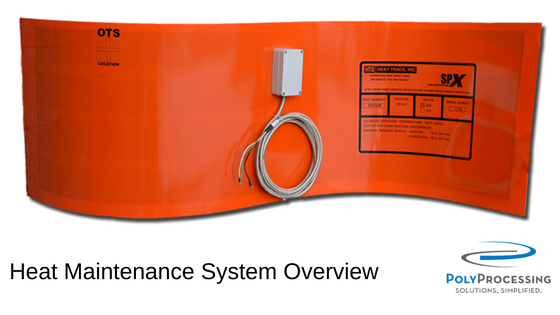Heat Maintenance System Overview
 Maintaining the proper temperature of a chemical is often critical to safe storage. For example, sodium hydroxide, at a 50% concentration will start to crystalize at or below temperatures of 60 degrees Fahrenheit. With polyethylene tanks, heat tracing and insulation is available to maintain the specific temperature of the chemical being stored. Heating pads and foam insulation combine to maintain the chemical temperature even when the tank is exposed to lower ambient temperatures.
Maintaining the proper temperature of a chemical is often critical to safe storage. For example, sodium hydroxide, at a 50% concentration will start to crystalize at or below temperatures of 60 degrees Fahrenheit. With polyethylene tanks, heat tracing and insulation is available to maintain the specific temperature of the chemical being stored. Heating pads and foam insulation combine to maintain the chemical temperature even when the tank is exposed to lower ambient temperatures.
System Overview
The poly tank heating system is comprised of tank heating pads and a temperature controller, or thermostat. The quantity and size of the heating pads, or SPX Pads®, is determined by the size of the tank, the required chemical temperature, and ambient conditions. Tank heating systems can be built to a Delta T of 30, 60, and 100 degrees F. The temperature controller is a redundant system designed to prevent overages and overheating. The controller can also connect to a SCADA system or alarm to monitor the temperature of the chemical.
Insulation is applied to the tank to help maintain the temperature of the chemicals and to help prevent temperature change from environmental factors. The insulation is then covered in a mastic coating of latex paint.
Frequently Asked Questions
Here are a few frequently asked questions that we hear from customers around setting up a temperature control system for polyethylene chemical storage tanks.
- What is the insulation R-value (measure of thermal resistance)? The tank insulation used in heating systems has an R-value of 6.3 per inch.
- How thick is the insulation? Insulation is a standard 2" thick with an R-value of 6.3. Keep this addition to the diameter of the tank in mind when determining placement of the tank, shipping, and any restraints or fittings that may be impacted.
- How do you determine the correct delta T of a system? First determine the lowest temperature that you could experience in the environment where the tank is stored. Next take the delta T number and subtract that lowest temperature. If the result is higher than the delta T rating for the tank, then your tank is not adequate to handle the ambient temperature and you need to move up to a higher delta T rated system.
- How do you determine wattage of the heating system? To determine the wattage of the tank heating system, note the name and quantity of the heating pads. The SPX Pad® SPX210 produces 210 watts while the SPX Pad® SPX420 produces 420 watts. Multiply the number of pads by the wattage to determine total heating wattage.
- How do you determine the amperage draw of the heating system? Unless a system has been modified, typically all systems are based on a 110 to 120-voltage supply. Amperage draw can be determined by dividing the total watts by the voltage supply. Here's an example. If the system you have has three SPX Pad® SPX210 heating pads, you would multiply the watts per pad (210) by 3 pads for a 630 watt system. Then, divide the total wattage of the system by the 110-volt supply, giving you a 5.73 amp system.
Poly Processing Company, along with HTD Heat Trace, have developed an updated Installation, Operation and Maintenance Manual for Heating Systems installed on Poly Processing Tanks.
For questions regarding heat maintenance systems, please call 866-765-9957 (866-POLY-XLPE) or talk to a chemical storage tank system expert today.
- September 13, 2016
- Topics: Fittings and Accessories
About Poly Processing
Posts By Topic
Tech Talk Podcast Episodes
Subscribe By Email
Recent Posts
- The Best of 2025 - Top 5 Chemical Storage Blogs
- Installation Tips for Chemical Storage Tanks: Site Preparation and Offloading
- Understanding pH and Chemical Concentration When Choosing a Chemical Tank
- Maximizing Fill Efficiency: Selecting the Optimal Fill Line System
- Chemical Storage Tanks: A Quick Guide for End Users
Tank Configurator

Find the recommended tank and system components for your chemical storage challenge.
Configure a Tank Package



